Abstract
The body-centered cubic (BCC)-structured magnesium–lithium (Mg-Li) alloy is the lightest metal material, but its mechanical properties are poor, especially its strength. In this study, the effect of adding rare earth Y on the microstructure and mechanical properties of as-cast BCC Mg-11Li-6Zn-xY (x = 0, 0.5, 1.2, and 2, in wt.%) alloys was investigated. The results revealed that massive amounts of nano-scale θ (MgLiZn) and/or θ’ (MgLi2Zn) precipitated inside the grains, and some θ phases precipitated at the grain boundaries in the Mg-11Li-6Zn alloy. With the addition of Y, W phases formed at the grain boundary, their content gradually increased with the Y concentration, and the grain size decreased simultaneously. The Mg-11Li-6Zn-0.5Y alloy exhibited higher ultimate tensile strength (190 MPa) and elongation (27%) at room temperature than those (170 MPa and 22%) of the Mg-11Li-6Zn alloy, presenting improvements of 11.8% and 22.7% in strength and ductility, respectively. The improvements in the mechanical properties of the Mg-11Li-6Zn alloy achieved by adding less Y could be attributed to the formation of moderate W phases and a reduction in grain size. However, once the addition of Y became excessive, the mechanical properties of the Mg-11Li-6Zn-1.2Y alloy were reduced due to the formation of too many reticular W phases. In addition, the Mg-11Li-6Zn-2Y alloy containing the highest Y content had the lowest ultimate tensile strength, 163 MPa, and highest ductility, 38%, due to the combined effect of the most reticular W phases and the smallest grains. Furthermore, the fracture morphology of the Mg-11Li-6Zn alloy displayed apparent necking, which became insignificant after the addition of Y, indicating that this addition could improve its uniform plastic deformation ability.
1. Introduction
Due to the increasing demand for lightweight structural components in the automotive, aerospace, electronics, and medical fields, magnesium–lithium (Mg-Li) alloys have received widespread attention, as they are the lightest metal structural materials [1,2,3,4,5,6]. However, their low absolute strength greatly limits the applications of Mg-Li alloys in practice, even though adding Li can improve their ductility [7,8,9]. In addition, the crystal structure of Mg-Li alloys can be altered by varying the Li concentration [10]. Specifically, when the Li content is lower than 5.7 wt.%, the matrix is the α-Mg phase with an HCP structure. With the Li content increasing to 5.7~10.3 wt.%, the matrix is composed of a duplex structure of HCP α-Mg and BCC β-Li phases. When the Li content exceeds 10.3 wt.%, only a BCC β-Li single phase forms in the matrix.
It is well recognized that an increased Li content is beneficial for improving the plasticity of Mg alloys [11,12,13,14,15,16,17]. By investigating the effect of the Li content on the mechanical properties of Mg-Li-Zn alloys, Takuda et al. found that the elongation of the alloy with 9 wt.% Li reached 71%, which was two times higher than that of the alloy with 6 wt.% Li [17]. Compared with an HCP α-Mg Mg-Li alloy with a lower Li content, the plasticity of a BCC β-Li Mg-Li alloy was improved, but its strength showed an opposite trend [18]. To modify the mechanical strength of Mg-Li alloys, alloying is an effective method [19,20,21,22,23,24]. For example, Li et al. found that the formation of a softened θ phase and a hardened θ’ phase in a Mg-11Li alloy with the addition of Zn effectively improved the strength and plasticity of the alloy [19]. Amongst various alloys, an as-cast Mg-11Li-6Zn alloy presented the highest yield strength and elongation, with 173 MPa and 30%, respectively, representing an approximately 2.5 times improvement in strength compared to a binary Mg-11Li alloy without Zn [19]. Therefore, to further improve the strength of Mg-Li alloys, adding rare earth elements is a common method [25,26,27].
Among the rare earth (RE) elements, yttrium (Y) generally has an important influence on the microstructure and mechanical properties of magnesium alloys [28,29,30,31,32]. For example, Y can be segregated at the stacking fault location and refine the grain size to improve the mechanical properties of magnesium alloys at room and high temperatures [32,33,34]. Therefore, it is of great significance to introduce Y into Mg-Li systems to improve their mechanical properties by regulating the θ/θ’ phases or forming new phases in Mg-11Li-6Zn alloys. If the content of Y is appropriate in a Mg-Li-Zn alloy, it is possible that a quasicrystalline phase (I-Mg3Zn6Y), W phase (Mg3Zn3Y2), or long-period stacking ordered (LPSO, Mg12ZnY, and Mg12Zn3Y6) phase could form, and the mechanical properties could be further improved [28,29,35]. For example, Liu et al. reported that adding Y and Zn and controlling the Y/Zn ratio to form the W phase in a Mg-14Li alloy refined its grains and improved its mechanical strength, which reached 150 MPa, showing a significant improvement compared with that of a binary Mg-14Li alloy [30]. As a result, the addition of Y in a Mg-Li-Zn alloy, whether segregated or to form a second phase, will trigger the precipitation of the original Zn atoms, inevitably changing the composition and distribution of the second phases. Thus, the mechanical properties will also be affected.
Based on the above, investigations of Y in relation to the microstructures, mechanical properties, and fracture behaviors of Mg-Li alloys are currently lacking, and its underlying mechanisms have not yet been revealed. In this study, a series of Mg-11Li-6Zn-based alloys with different Y contents are selected, and three questions are posed: (i) How does the microstructure evolve after adding different contents of Y? (ii) Do the mechanical properties improve? (iii) If the mechanical properties improve, what is the underlying mechanism? As a result, this study aims to reveal the effect of Y on the microstructures, mechanical properties, and fracture behaviors of Mg-11Li-6Zn-based alloys in detail, and the aforementioned questions are answered simultaneously. If high-performing Mg-11Li-6Zn alloys containing different Y elements can be achieved in this work, it will present wide application prospects in fields such as automotive engineering, aerospace, electronics, humanoid robots, and more.
2. Materials and Methods
As-cast Mg-11Li-6Zn (in wt.%)-based alloys with different Y contents (0.5, 1.2, and 2, in wt.%) were used in this study; the alloys were fabricated in a vacuum mid-frequency induction furnace. The raw materials consisted of commercial pure magnesium (99.95 wt.%), pure lithium (99.90 wt.%), pure zinc (99.90 wt.%), and a Mg-30Y master alloy. The chemical composition of the as-cast ingots was determined by an inductively coupled plasma atomic emission spectrum (ICP-AES) apparatus, and the results are shown in Table 1. The microstructure of the alloys was characterized by optical microscopy (OM), X-ray diffraction (XRD), and scanning electron microscopy (SEM). The OM and SEM samples were gradually ground from 400 grit to 5000 grit with sandpaper, followed by water polishing with a 0.5 µm diamond suspension until the surface appeared smooth. Then, the polished surfaces were etched with 5% nitric acid + 95% ethanol before OM observation, but not for SEM observation. The XRD analysis was performed at a scanning speed of 6°/min and a scanning range of 10~90°, and the phase composition was confirmed by matching the standard PDF cards. In addition, transmission electron microscopy (TEM) coupled with energy-dispersive X-ray spectroscopy (EDS) was used to further analyze the second phases. TEM samples of thin foil were prepared by mechanical thinning and subsequent argon ion milling. In terms of the tensile experiments, tensile samples with a gauge length of 20 mm, width of about 3 mm, and thickness of about 2 mm were cut from the as-cast ingots. The tensile tests were carried out at a constant strain rate of 1 × 10−3 s−1 at room temperature, and each test was repeated at least three times to ensure the reliability. The ASTM E8-04 standard was used for the tension tests. In addition, one side surface of the samples was finely polished before tensile testing, and the polished surface was further observed by SEM to analyze the deformation microstructure near the fractures after tensile failure. Moreover, the fracture surfaces were also observed by SEM. A schematic diagram of selected samples for the observation of the original microstructure and fracture morphologies is shown in Figure 1.

Table 1.
Chemical composition of Mg-Li alloys in experiment.

Figure 1.
Schematic illustration of selected samples cut from the ingots to observe the microstructure and fracture morphology.
3. Results and Discussion
3.1. Microstructure
XRD patterns of the as-cast Mg-11Li-6Zn-xY (x = 0, 0.5, 1.2, 2, in wt.%) alloys are shown in Figure 2, and the four as-cast alloys are, respectively, known as LZ116, LZ116-0.5Y, LZ116-1.2Y, and LZ116-2Y herein. It can be seen that the diffraction peaks of β-Li, α-Mg, θ (MgLiZn), and θ’ (MgLi2Zn) are clear in the XRD patterns of the as-cast LZ116 alloy without Y, while the addition of Y leads to the formation of additional W-Mg3Zn3Y2 phases in the as-cast LZ116-0.5Y, LZ116-1.2Y, and LZ116-2Y alloys. In addition, the intensity of the diffraction peaks of the W phase is enhanced with an increase in the Y content, indicating an increasing content of the W phase with the addition of Y. The OM microstructures of the as-cast LZ116, LZ116-0.5Y, LZ116-1.2Y, and LZ116-2Y samples are shown in Figure 3, revealing that the second phases are mainly formed at the grain boundaries and their content increases with the Y addition. As the θ (MgLiZn) and θ’ (MgLi2Zn) phases in the as-cast LZ116 alloy are small and can only be observed by SEM and TEM [19], in addition to the fact that the lithium content is located in the range of the BCC Mg-Li alloy (with more than 10.3 wt.% Li), the primary second phases formed at the grain boundary can be determined as the W phase in the LZ116-0.5Y, LZ116-1.2Y, and LZ116-2Y alloys, which is also common in Mg-Zn-Y alloys [29]. Moreover, the LZ116 sample without Y presents the largest grain size, with the average grain size being about 472 µm. The LZ116-0.5Y and LZ116-1.2Y samples display a moderate grain size, while the LZ116-2Y sample exhibits the smallest grain size, with the average size being about 190 µm. Therefore, the grain size of the as-cast LZ116 alloy is gradually decreased with the addition of Y. Previous studies have demonstrated that the Y element may be able to refine the microstructure of Mg alloys to improve the mechanical properties [36], and herein, the addition of Y also exhibits an inhibiting effect on the grain growth in the BCC Mg-Li-Zn system.
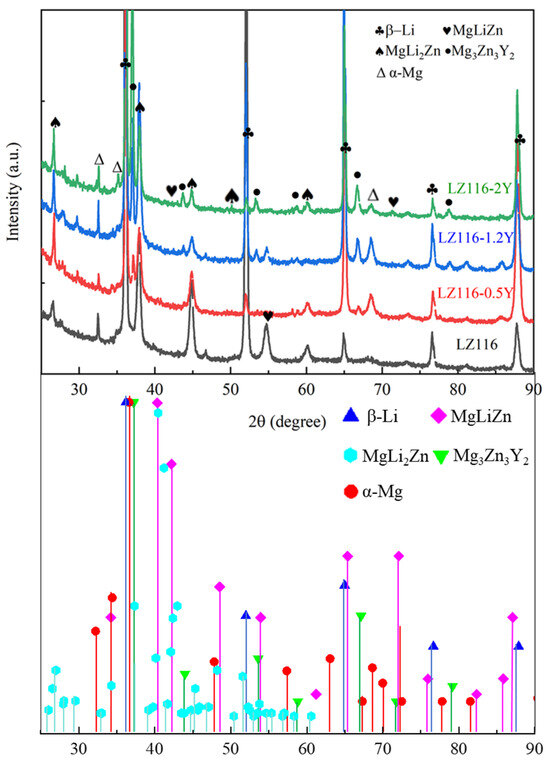
Figure 2.
XRD patterns of LZ116, LZ116-0.5Y, LZ116-1.2Y, and LZ116-2Y alloys.
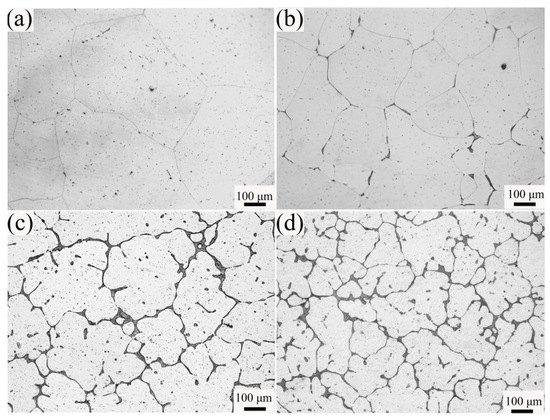
Figure 3.
OM images of as-cast (a) LZ116, (b) LZ116-0.5Y, (c) LZ116-1.2Y, and (d) LZ116-2Y alloys.
SEM observations of the four as-cast alloys are shown in Figure 4, further confirming the increasing second phases in the as-cast LZ116-based alloys with the addition of Y. Based on previous work, the metastable nano-scale θ’ phases in the as-cast LZ116 alloy are generally massive and distributed inside the grains, and the large θ phases are distributed at the grain boundaries [19]. As such, the second phases observed by SEM in the as-cast LZ116 alloy can be determined as θ (MgLiZn) phases and are mainly located at the grain boundaries (Figure 4e). For the Mg-Li-Zn system, the Mg-Li-Zn phase particles are generally θ’ and θ phases, and the metastable θ’ phase could gradually transform into a stable θ phase even at room temperature, having an important impact on the mechanical properties of Mg-Li alloys [27]. Compared with the LZ116 alloy, the LZ116-0.5Y, LZ116-1.2Y, and LZ116-2Y alloys possess distinguished second phases and eutectic characteristics at trivalent boundaries. The eutectic phases can be determined as the W phase based on the XRD results. In addition, it is common for the W phase to be distributed at the grain boundaries in Mg alloys [37,38]. As the formation of the W phase requires the Zn element, the MgLiZn phase formed in the LZ116 alloy can be gradually replaced by the eutectic W phases consuming the Zn in the LZ116-0.5Y, LZ116-1.2Y, and LZ116-2Y alloys during solidification. The eutectic W phases will then become coarse with the increase in the Y content. As a result, adding the Y element contributes to the formation of the W phase at trivalent boundaries.
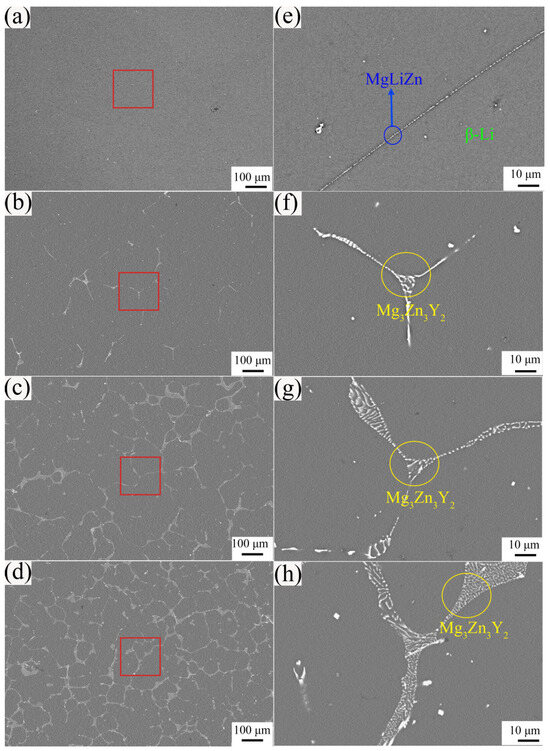
Figure 4.
SEM images of as-cast (a) LZ116, (b) LZ116-0.5Y, (c) LZ116-1.2Y, and (d) LZ116-2Y alloys. Images (e–h) are the high-magnification observations of the squared areas in images (a–d), respectively.
To further investigate the composition of the possible phases in these serial alloys, the matrix of the LZ116-0.5Y alloy was further characterized by TEM and EDS, as shown in Figure 5. It can be seen that massive nano-precipitations are distributed in the matrix (Figure 5a), and the selected area diffraction patterns (SADPs) shown in Figure 5b confirm the BCC structure of the β-Li matrix. Meanwhile, additional SADP spots corresponding to the nano-precipitations can also be observed due to the selected regions covering some precipitations, which have been confirmed as θ’ phases in previous work [19]. The EDS analysis demonstrates that the nano-precipitations are enriched Zn (Figure 5c), and the level of Zn content in the matrix is lower than that of the precipitations (Figure 5d), which is also in agreement with the literature [19]. Therefore, these nano-precipitated phases which are uniformly distributed in the β-Li phase matrix can pin the dislocations and promote the deformation resistance of the β-Li matrix, improving the mechanical strength of the alloys [27]. In addition, some continuous-phase particles distributed at the grain boundaries are also observed by TEM (Figure 6a), and the apparent pure regions are accompanied by the phase particles, broadening the grain boundary of the β-Li matrix filled with nano-precipitations. In our previous study, the apparent pure regions at the grain boundary were confirmed as the α-Mg phase [19], and the precipitation of α-Mg in the β-Li matrix was also reported [39,40]. EDS mapping illustrates that the phase particles are enriched with Zn (Figure 6c,d), and they are determined as the θ (MgLiZn) phase by the SADPs (Figure 6b), which corresponds to studies from the literature [41]. Furthermore, the large phases located at the grain boundary of LZ116-0.5Y were analyzed by TEM, as shown in Figure 7. The bright-field image of the phase displays a rod-like feature, and its composition is rich in Mg, Zn, and Y elements, as revealed by the EDS results. Combined with the element compositions and XRD results, the rod-like phases can be defined as W phases, which are generally hard and brittle, as well as prone to fracturing during the deformation process, thereby destroying the integrity of the β-Li matrix and reducing its strength [42].
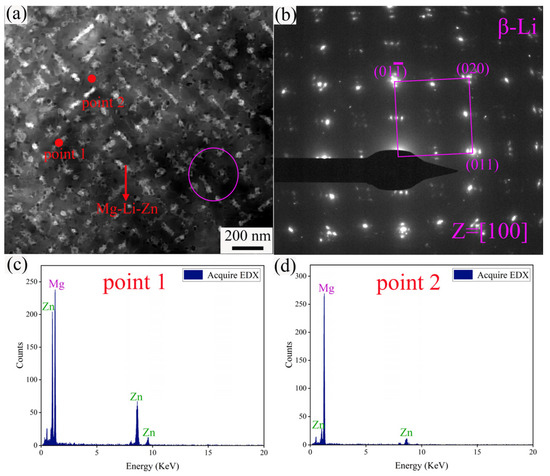
Figure 5.
TEM analysis of the grain interior in the as-cast LZ116-0.5Y alloy: (a) bright-field image; (b) selected area diffraction pattern from the selected round pink region in image (a); (c,d) EDS analysis of the precipitation marked by point 1 and the matrix marked by point 2 in image (a), respectively.
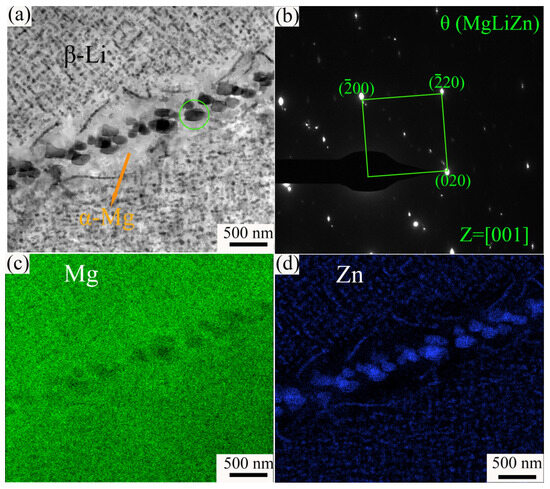
Figure 6.
TEM analysis of the grain boundary of the as-cast LZ116-0.5Y alloy: (a) bright-field image; (b) selected area diffraction pattern from the selected round area in image (a); (c,d) EDS mapping corresponding to image (a).
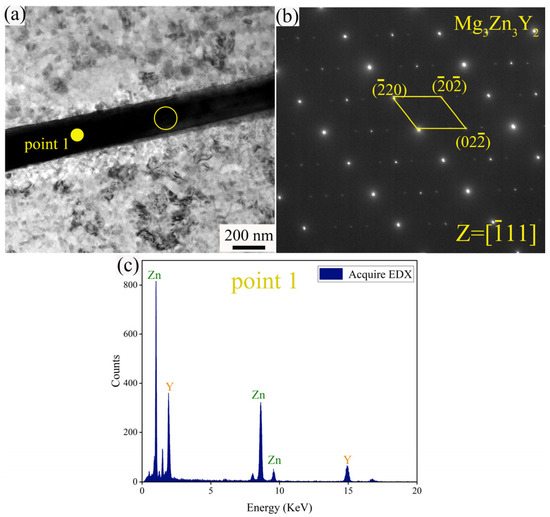
Figure 7.
TEM analysis of the large second phase in the as-cast LZ116-0.5Y alloy: (a) bright-field image; (b) selected area diffraction pattern from the selected round yellow area in image (a); (c) EDS point analysis of the second phase.
3.2. Mechanical Properties
The engineering stress–strain curves of the four alloys are shown in Figure 8, and the corresponding mechanical properties, namely yield strength (YS), ultimate tensile strength (UTS), and the elongation-to-failure ratio (EL), are listed in Table 2. For the four alloys, the work-hardening effect is trivial, and the stress rapidly reaches the ultimate value after yielding. Then, the stress gradually decreases, displaying a typical work-softening effect. This special deformation phenomenon of Mg-Li alloys at room temperature is common due to the extreme movability of slip dislocations [40], indirectly demonstrating their inadequate strength and high-temperature performance. For the LZ116 alloy without the addition of the Y element, the work-softening effect is significant at the later deformation stage. Compared with the LZ116 alloy, the strength and elongation of the LZ116-0.5Y alloy are simultaneously enhanced after adding 0.5 wt.% Y, i.e., the YS, UTS, and EL of the LZ116 alloy are improved from 159 MPa, 170 MPa, and 22% to 178 MPa, 190 MPa, and 27% in the LZ116-0.5Y alloy, respectively. However, with the increase in Y to 1.2 wt.%, the YS, UTS, and EL are reduced to 151 MPa, 165 MPa, and 23%, which can be attributed to the formation of a relatively large amount of hard W phases. Due to the increase in W phases at the grain boundary of the LZ116-1.2Y alloy, stress concentration easily occurs around these phases to accelerate the formation of cracks, reducing the mechanical strength and elongation. When the addition of Y is further increased to 2 wt.%, the strength of the LZ116-2Y alloy is nearly identical to that of the LZ116-1.2Y alloy, but the elongation is improved to 38% due to the contribution of the refined grains (Figure 3d). Therefore, only a moderate addition of the Y element in the LZ116 alloy, such as 0.5 wt.% in this study, improves strength and ductility. As the alloying elements of Zn and/or Y are supersaturated in these four alloys, the precipitated θ and θ’ phases can be considered equivalent at room temperature. The main differences in the four alloys are the grain size and the content of the W phase. Here, the main reason for the improvement in the mechanical properties of the LZ116-0.5Y alloy is a combination of refinement strengthening and second-phase strengthening resulting from the moderate content of W phases. On the other hand, based on the microstructure, the grain size reduces with an increase in the Y element, improving the strength and plasticity of the LZ116-0.5Y alloy. However, the strength of the LZ116-1.2Y alloy is lower compared to the LZ116 and LZ116-0.5Y alloys. This can be attributed to the fact that the increased strength from refinement is less than the overall reduction caused by the laceration of hard and brittle W phases within the matrix [43]. When the Y content reaches 2 wt.%, the grain size of the LZ116-2Y alloy is further reduced, and the strength and elongation should be improved based on the mechanism of refinement strengthening. However, the W phases are reticular and are found mostly in the matrix, providing a detrimental effect on the mechanical strength. Therefore, due to the combined influence given above, the LZ116-2Y alloy presents excellent ductility but undesirable strength.
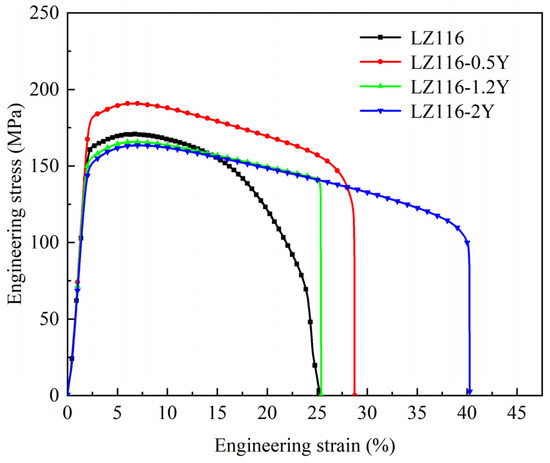
Figure 8.
Engineering stress–strain curves of as-cast LZ116, LZ116-0.5Y, LZ116-1.2Y, and LZ116-2Y alloys.

Table 2.
Tensile stress–strain data for as-cast Mg-11Li-6Zn-xY (x = 0, 0.5, 1.2, and 2, in wt.%) alloys.
3.3. Fracture Morphologies
The fracture surface morphologies of the LZ116, LZ116-0.5Y, LZ116-1.2Y, and LZ116-2Y alloys are shown in Figure 9. It can be seen that necking is apparent in the LZ116 alloy, indicating the lowest resistance to the uniform plastic deformation, which is also in agreement with the tensile curves in Figure 8. In the high-magnification image of the LZ116 alloy, a certain number of dimples are observed on the fracture surface, and some cleavage planes appear after adding 0.5 wt.% Y to form the LZ116-0.5Y alloy. Many more cracks can be observed at low magnification, indicating the effect of the W phase on fracture behaviors. In addition, many dimples with less cleavage planes are observed at high magnification, and the corresponding ductility is better than that of the LZ116 alloy. Regarding the LZ116-1.2Y alloy, the fracture morphology is different from those of the LZ116 and LZ116-0.5Y alloys, and the cleavage planes occupy a considerable fraction on the surface at low magnification. When the observation is enlarged, some dimples still exist, and the trident W phases are exposed, indicating the detrimental effect of the reticular W phase on the ductility of the LZ116-1.2Y alloy. In terms of the LZ116-2Y alloy containing the most W phases, the fractography presents a different feature from the others at low magnification, and the high-magnification observations reveal massive dimples with a smaller size, with the cleavage planes barely visible. As a result, the LZ116-2Y alloy exhibits the best ductility. Based on the above, although the dimples of the LZ116 alloy are large and deep, there are fewer, and the river pattern is the most obvious, indicating the lowest ductility. Compared to the LZ116 alloy, the LZ116-0.5Y alloy presents many more and larger dimples; meanwhile, the river pattern is simplified, resulting in improved ductility. For the LZ116-1.2Y alloy, the number of dimples is decreased, many more cleavage planes (river patterns) are observed due to the existence of many more W phases, and the ductility is decreased once again. Regarding the LZ116-2.0Y alloy containing the most W phases, many more tiny dimples form due to the effect of scattered fine W phase particles in the matrix, and the river pattern is trivial, resulting in the best ductility. On the other hand, for the LZ116-0.5Y, LZ116-1.2Y, and LZ116-2Y alloys, second-phase particles are always located at the bottom of the dimples, while this is not the case for the dimples in the LZ116 alloy without Y. Therefore, the existence of phase particles can promote the formation of ductility dimples in LZ116-Y alloys during deformation and improve the deformation tolerance [44], which is in agreement with the tensile curves.
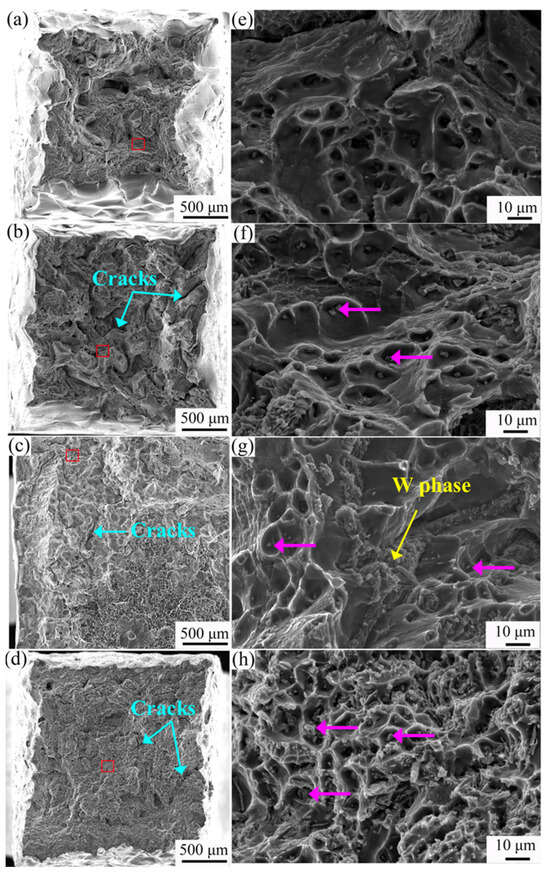
Figure 9.
SEM images of the fracture surface morphologies of as-cast (a) LZ116, (b) LZ116-0.5Y, (c) LZ116-1.2Y, and (d) LZ116-2Y alloys. Images (e–h) are high-magnification observations of the squared areas in images (a–d), respectively, and the pink arrows indicate the second phases at the bottom of the dimples.
The fracture morphologies of the side surfaces are displayed in Figure 10, and the apparent necking of the LZ116 alloy is further revealed, with many cracks observed at the grain boundaries. Meanwhile, the outlines of deformed grains along the tensile direction become clear. As such, the deformation resistance of the LZ116 alloy is low, leading to poor mechanical performance. For the LZ116-0.5Y alloy, the deformation traces are more noticeable, and dense slip lines cover the surface; however, the cracks seem to be decreased compared with the LZ116 alloy. Therefore, adding less Y can improve the deformation resistance, enhancing the mechanical properties. Regarding the LZ116-1.2Y alloy, the side surface presents a relatively flat feature and limited deformation traces, and the cracks are preferentially formed at the grain boundaries filled with W phases. The side fracture morphologies of the LZ116-1.2Y alloy further illustrate the poor ductility. In terms of the LZ116-2Y alloy with the highest Y content and the smallest grains, the deformation traces are significant, with some slip lines cutting through the second phases, indicating the best plastic deformation ability. Limited cracks are preferentially formed at the interaction points between the slip line and the second phase. In addition, the W phases are deformed and present a dispersed distribution in the matrix, tearing the matrix and thus reducing the mechanical strength. Based on the above, the microstructure of Mg-11Li-6Zn-based alloys with and without the addition of the Y element is closely correlated with the mechanical properties and fracture behaviors.
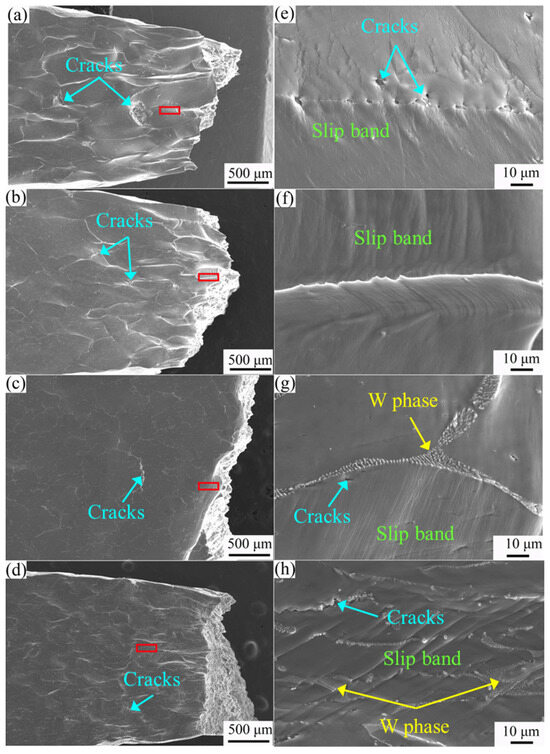
Figure 10.
SEM images of the side surface fractures of as-cast (a) LZ116, (b) LZ116-0.5Y, (c) LZ116-1.2Y, and (d) LZ116-2Y alloys. Images (e–h) are the high-magnification observations of the squared areas in images (a–d), respectively.
4. Conclusions
The effect of the Y element content on the microstructure and mechanical properties of BCC Mg-11Li-6Zn matrix alloys was investigated, and the following conclusions can be drawn:
- (1)
- Massive nano-scale precipitations of θ (MgLiZn) and/or θ’ (MgLi2Zn) are formed inside the grains, while limited θ (MgLiZn) and α-Mg phases precipitate at the grain boundaries in the LZ116-based alloy. With the addition of the Y element in the as-cast LZ116 alloy, the reticular W phase forms at the grain boundary, its content gradually increases with the Y concentration, and the grain size is decreased simultaneously.
- (2)
- The mechanical strength of the as-cast LZ116-0.5Y alloy reaches a maximum of 190 MPa after the addition of 0.5 wt.% Y, presenting a 20 MPa improvement compared with that of LZ116 without Y, and the elongation is also improved simultaneously to 27%.
- (3)
- The mechanical strength is reduced when the Y content is further increased to 1.2 and 2 wt.% due to the increasing content of W phases, while the elongation of the LZ116-2Y alloy is enhanced as the grains are refined.
- (4)
- All four alloys present ductile fractures confirmed by the apparent dimples on the fracture surface, while the dimple features differ for the different alloys.
- (5)
- The fracture morphology of the as-cast LZ116 alloy exhibits a noticeable necking feature, which is insignificant after the addition of the Y element, indicating that the Y element can improve the uniform plastic deformation ability.
Author Contributions
Conceptualization, C.L. and Z.Z.; methodology, X.K.; validation, G.X., X.K. and B.S.; data analysis, H.L., X.K., G.X. and B.S.; formal analysis, H.L. and B.S.; investigation, H.L.; resources, C.L.; data curation, X.K. and G.X.; writing—original draft preparation, H.L.; writing—review and editing, Z.Z. and C.L.; supervision, Z.Z.; project administration, C.L.; funding acquisition, C.L. All authors have read and agreed to the published version of the manuscript.
Funding
This work was supported financially by the Guangdong Basic and Applied Basic Research Foundation (Grant Nos. 2023A1515012299 and 2024A1515030065), Basic and Applied Basic Research Project of Guangzhou (Grant Nos. 2024A04J6299), and Young Talent Support Project of Guangzhou Association for Science and Technology (Grant No. QT2024-012).
Data Availability Statement
The raw data supporting the conclusions of this article will be made available by the authors on request.
Conflicts of Interest
The authors declare no conflicts of interest.
References
- Wei, Z.; Dong, H.; Zhang, J.H.; Wu, R.Z.; He, Y.Y.; Bao, R.R.; Zhang, X.B.; Wang, J.H. Preparation of high strength Mg–Li–Zn–Y alloy by MgLi2Zn precipitation. Mater. Sci. Eng. A 2024, 890, 145842. [Google Scholar] [CrossRef]
- Liu, Z.; Nie, J.F.; Zhao, Y.H. Effect of deformation processing on microstructure evolution and mechanical properties of Mg−Li alloys: A review. Trans. Nonferrous Met. Soc. China 2024, 34, 25. [Google Scholar] [CrossRef]
- Hsu, Y.; Lu, Y.P.; Wang, S.Y.; Zheng, Y.F.; Xia, D.F.; Liu, Y.S. Magnesium alloys in tumor treatment: Current research status, challenges and future prospects. J. Magnes. Alloys 2023, 11, 3399–3426. [Google Scholar] [CrossRef]
- Li, C.Q.; Li, X.; Ke, X.T.; Dong, Y.; Wang, N.G.; Wang, S.D.; Zhang, Z.R. Enhancing corrosion resistance of Mg-Li-Zn-Y-Mn alloy containing long period stacking ordered (LPSO) structure through homogenization treatment. Corros. Sci. 2024, 228, 111829. [Google Scholar] [CrossRef]
- Wang, D.L.; Xu, D.K.; Wang, B.J.; Yan, C.J.; Wang, S.; Xu, X.B.; Zhang, L.; Lu, C.L. Effect of cross rolling on the microstructure and mechanical performance of a dual-phase structured Mg-8Li-6Zn-1Y (in wt.%) alloy. J. Mater. Sci. Technol. 2024, 176, 132–144. [Google Scholar] [CrossRef]
- Mineta, T. Review—Materials design for improving mechanical properties of ultra-lightweight Mg-Li based alloys. Mater. Trans. 2024, 65, 455–465. [Google Scholar] [CrossRef]
- Sun, J.W.; Huang, Y.C.; Liu, W.C.; Wu, G.H.; Qi, F.Z.; Guo, Y.J. Enhanced ductility by tailoring precipitations in micron TiB2 reinforced Mg-Li matrix composites with high modulus. Mater. Des. 2024, 239, 112739. [Google Scholar] [CrossRef]
- Li, J.; Zhong, L.; Wang, J.; Feng, Z.; Qu, Y.; Xu, R. Synergistic improvement of mechanical and electromagnetic shielding properties of a Mg-Li-Y-Zn alloy following heat treatment. J. Magnes. Alloys, 2024; in press. [Google Scholar] [CrossRef]
- Wei, Z.; Zhang, J.H.; Bao, R.R.; Wu, R.Z.; Zhang, H. Achieving high strength in a Mg–Li–Zn–Y alloy by α-Mg precipitation. Mater. Sci. Eng. A 2022, 846, 143272. [Google Scholar] [CrossRef]
- Nayeb-Hashemi, A.A.; Clark, J.B. The Li-Mg (Lithium-Magnesium) system. Bull. Alloy Phase Diagr. 1984, 5, 365–374. [Google Scholar] [CrossRef]
- Jeong, H.T.; Lee, S.W.; Kim, W.J. Superplasticity of fine-grained Mg-10Li alloy prepared by severe plastic deformation and understanding its deformation mechanisms. J. Magnes. Alloys 2024, 12, 316–331. [Google Scholar] [CrossRef]
- Ji, H.; Wu, G.H.; Liu, W.C.; Liang, X.L.; Liao, G.L.; Ding, D.H. Microstructure characterization and mechanical properties of the as-cast and as-extruded Mg-xLi-5Zn-0.5Er (x = 8, 10 and 12 wt%) alloys. Mater. Charact. 2020, 159, 110008. [Google Scholar] [CrossRef]
- Cui, X.F.; Guo, Y.L.; Yang, Y.; Zhu, Y.; Zhou, G.; Cao, T.T.; Luo, Q.; Wei, G.B.; Li, Q.; Jiang, B.; et al. High-ductility Mg-9Li-1Zn-2Gd-1.2Mn alloy prepared via traditional hot extrusion. Mater. Sci. Eng. A 2024, 893, 146094. [Google Scholar] [CrossRef]
- Kumar, V.; Govind Shekhar, R.; Balasubramaniam, R.; Balani, K. Microstructure evolution and texture development in thermomechanically processed Mg–Li–Al based alloys. Mater. Sci. Eng. A 2012, 547, 38–50. [Google Scholar] [CrossRef]
- Hooper, R.J.M.; Bryan, Z.L.; Manuel, M.V. The effect of indium additions on Mg-Li and Mg-Li-Al alloys. Met. Mater. Trans. A 2014, 45, 55–59. [Google Scholar] [CrossRef]
- Jin, S.Y.; Ma, X.C.; Wu, R.Z.; Wang, G.X.; Zhang, J.H.; Krit, B.; Betsofen, S.; Liu, B. Advances in micro-arc oxidation coatings on Mg-Li alloys. Appl. Surf. Sci. Adv. 2022, 8, 100219. [Google Scholar] [CrossRef]
- Takuda, H.; Matsusaka, H.; Kikuchi, S.; Kubota, K. Tensile properties of a few Mg-Li-Zn alloy thin sheets. J. Mater. Sci. 2002, 37, 51–57. [Google Scholar] [CrossRef]
- Yang, K.; Bai, W.W.; Li, B.; Chen, H.; Li, G.; Wei, G.B.; Liu, J.W. Thermal deformation behavior and microstructural evolution of multicomponent Mg-Li-Zn-Al-Y alloys under hot compression. Materials 2024, 17, 489. [Google Scholar] [CrossRef]
- Li, C.Q.; Deng, B.B.; Dong, L.J.; Liu, X.; Du, K.Q.; Shi, B.Q.; Dong, Y.; Peng, F.; Zhang, Z.R. Effect of Zn addition on the microstructure and mechanical properties of as-cast BCC Mg-11Li based alloys. J. Alloys Compd. 2022, 895, 162718. [Google Scholar] [CrossRef]
- Huang, Y.C.; Zhang, Q.D.; Ooyang, S.J.; Sun, F.Z.; Sun, J.W.; Li, H.Y.; Wu, G.H.; Chen, P.J.; Liu, W.C. Effects of Zn and Gd contents and their ratios on microstructure and mechanical properties of as-cast and as-extruded Mg−8Li alloys. Trans. Nonferrous Met. Soc. China 2024, 34, 798–811. [Google Scholar] [CrossRef]
- Yang, Y.W.; Su, K.Q.; Zhao, K.; Li, H.R.; Guo, E.Y.; Chen, Z.N.; Xin, T.Z.; Kang, H.J.; Wang, T.M. Strengthening of duplex Mg–9Li–3Al–2Zn–1Sn alloy by solid solution and mixed rolling-induced second phase transition. Mater. Sci. Eng. A 2024, 900, 146491. [Google Scholar] [CrossRef]
- Deng, B.B.; Liang, D.H.; Li, C.Q.; Yan, C.J.; Dong, Y.; Wang, N.G.; Zhang, Z.R.; Han, E.H. Effect of Zn addition on the stress corrosion cracking of as-cast BCC Mg-11Li based alloys. Corros. Sci. 2024, 227, 111707. [Google Scholar] [CrossRef]
- Peng, X.; Liu, W.C.; Wu, G.H.; Ji, H.; Ding, W.J. Plastic deformation and heat treatment of Mg-Li alloys: A review. J. Mater. Sci. Technol. 2022, 99, 193–206. [Google Scholar] [CrossRef]
- Peng, X.; Liu, W.C.; Wu, G.H. Strengthening-toughening methods and mechanisms of Mg–Li alloy: A review. Rare Met. 2022, 41, 1176–1188. [Google Scholar] [CrossRef]
- Zhou, W.R.; Zheng, Y.F.; Leeflang, M.A.; Zhou, J. Mechanical property, biocorrosion and in vitro biocompatibility evaluations of Mg–Li–(Al)–(RE) alloys for future cardiovascular stent application. Acta Biomater. 2013, 9, 8488–8498. [Google Scholar] [CrossRef] [PubMed]
- Zhang, Y.; Zhang, J.; Wu, G.H.; Liu, W.C.; Zhang, L.; Ding, W.J. Microstructure and tensile properties of as-extruded Mg–Li–Zn–Gd alloys reinforced with icosahedral quasicrystal phase. Mater. Des. 2015, 66, 162–168. [Google Scholar] [CrossRef]
- Ji, H.; Liu, W.C.; Wu, G.H.; Ouyang, S.J.; Gao, Z.K.; Peng, X.; Ding, W.J. Influence of Er addition on microstructure and mechanical properties of as-cast Mg-10Li-5Zn alloy. Mater. Sci. Eng. A 2019, 739, 395–403. [Google Scholar] [CrossRef]
- Xu, D.K.; Liu, L.; Xu, Y.B.; Han, E.H. The strengthening effect of icosahedral phase on as-extruded Mg–Li alloys. Scr. Mater. 2007, 57, 285–288. [Google Scholar] [CrossRef]
- Liao, Q.Y.; Zhao, D.Z.; Le, Q.C.; Hu, W.X.; Jiang, Y.C.; Zhou, W.Y.; Ren, L.; Li, D.D.; Yin, Z.Y. Effect of artificial cooling extrusion on microstructure and mechanical properties of Mg–Zn–Y alloys. Acta Metall. Sin. Engl. Lett. 2024, 37, 1115–1127. [Google Scholar] [CrossRef]
- Liu, W.C.; Gao, Z.K.; Peng, X.; Wu, G.H.; Tong, X.; Xiao, L.; Wang, X.F.; Ding, W.J. Microstructural evolution and mechanical properties of as-cast and as-extruded Mg–14Li alloy with different Zn/Y and Zn/Gd addition. Adv. Eng. Mater. 2020, 22, 1527–2648. [Google Scholar] [CrossRef]
- Liu, J.A.; Liu, S.J.; Wang, B.; Sun, W.B.; Liu, X.J.; Han, Z.W. Compressive property and energy absorption characteristic of interconnected porous Mg-Zn-Y alloys with adjusting Y addition. J. Magnes. Alloys 2024, 12, 171–185. [Google Scholar] [CrossRef]
- Zhu, Q.C.; Li, Y.X.; Ding, Z.G.; Wang, J.; Liu, Y.X.; Zhang, H.; Xie, T.; Wang, M.C.; Zhu, H.; Ying, T.; et al. Unveiling precipitation behavior in Mg-Y based alloys. Mater. Des. 2021, 202, 109570. [Google Scholar] [CrossRef]
- Zhang, S.; Sun, Y.; Wu, R.Z.; Wang, X.; Chen, X.B.; Fernandez, C.; Peng, Q.M. Coherent interface strengthening of ultrahigh pressure heat-treated Mg-Li-Y alloys. J. Mater. Sci. Technol. 2020, 51, 79–83. [Google Scholar] [CrossRef]
- Yang, W.; Quan, G.F.; Ji, B.; Wan, Y.F.; Zhou, H.; Zheng, J.; Yin, D.D. Effect of Y content and equal channel angular pressing on the microstructure, texture and mechanical property of extruded Mg-Y alloys. J. Magnes. Alloys 2022, 10, 195–208. [Google Scholar] [CrossRef]
- Xu, D.K.; Han, E.H.; Liu, L.; Xu, Y.B. Influence of higher Zn/Y ratio on the microstructure and mechanical properties of Mg-Zn-Y-Zr alloys. Met. Mater. Trans. A 2009, 40, 1727–1740. [Google Scholar] [CrossRef]
- Su, N.; Wu, Q.Y.; Ding, C.Y.; Wu, Y.J.; Peng, L.M. Effect of Y and Gd solutes on grain refinement of the as-extruded Mg-Gd(-Y)-Zn-Mn alloys. J. Alloys Compd. 2023, 968, 171804. [Google Scholar] [CrossRef]
- Jiang, H.S.; Qiao, X.G.; Xu, C.; Kamado, S.; Wu, K.; Zheng, M.Y. Influence of size and distribution of W phase on strength and ductility of high strength Mg-5.1Zn-3.2Y-0.4Zr-0.4Ca alloy processed by indirect extrusion. J. Mater. Sci. Technol. 2018, 34, 277–283. [Google Scholar] [CrossRef]
- Luo, S.Q.; Tang, A.T.; Pan, F.S.; Song, K.; Wang, W.Q. Effect of mole ratio of Y to Zn on phase constituent of Mg-Zn-Zr-Y alloys. Trans. Nonferrous Met. Soc. China 2011, 21, 795–800. [Google Scholar] [CrossRef]
- Huang, Y.C.; Sun, J.W.; Qi, F.Z.; Guo, Y.J.; Wu, G.H.; Liu, W.C. Aging response and mechanism of dual-phase Mg-Li-Al-Zn alloy. J. Magnes. Alloys, 2024; in press. [Google Scholar] [CrossRef]
- Wang, Y.; Xia, Z.Y.; Xiong, J.P.; Zeng, G.; Wang, P.H.; Luo, L.; Wu, R.Z.; Wang, J.; Liu, Y. Enhancing the ductility of cast Mg-Li alloys via dispersed α-Mg phase mitigating the dimensionand distribution of interspersed eutectics along grain boundaries. J. Magnes. Alloys 2024, 12, 4722–4739. [Google Scholar] [CrossRef]
- Yamamoto, A.; Ashida, T.; Kouta, Y.; Kim, K.B.; Fukumoto, S.; Tsubakino, H. Precipitation in Mg–(4–13)%Li–(4–5)% Zn ternary alloys. Mater. Trans. 2003, 44, 619–624. [Google Scholar] [CrossRef]
- Xu, D.K.; Tang, W.N.; Liu, L.; Xu, Y.B.; Han, E.H. Effect of W-phase on the mechanical properties of as-cast Mg–Zn–Y–Zr alloys. J. Alloys Compd. 2008, 461, 248–252. [Google Scholar] [CrossRef]
- Jung, Y.G.; Yang, W.; Hyun, J.I.; Kim, S.K.; Lim, H.; Kim, D.H. Effects of I- and W-phases under identical conditions on microstructure and mechanical properties of as-cast Mg–Zn–Y alloys at room and elevated temperatures. Met. Mater. Int. 2020, 27, 5154–5164. [Google Scholar] [CrossRef]
- Song, W.J.; Wu, Z.Y.; He, S.; Liu, J.; Yang, G.; Zhao, X.K.; Li, Y.Z. Effect of Al on microstructure and mechanical properties of Mg-10Li-3Zn-1Y alloys. J. Mater. Eng. Perform. 2024, 33, 1059–9495. [Google Scholar] [CrossRef]
Disclaimer/Publisher’s Note: The statements, opinions and data contained in all publications are solely those of the individual author(s) and contributor(s) and not of MDPI and/or the editor(s). MDPI and/or the editor(s) disclaim responsibility for any injury to people or property resulting from any ideas, methods, instructions or products referred to in the content. |
© 2025 by the authors. Licensee MDPI, Basel, Switzerland. This article is an open access article distributed under the terms and conditions of the Creative Commons Attribution (CC BY) license (https://creativecommons.org/licenses/by/4.0/).